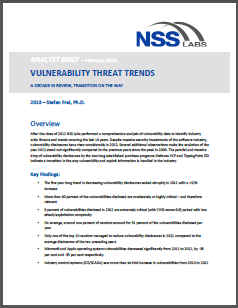Vulnerabilities, the bugbear of system administrators and security analysts alike, keep on piling up – ruining Friday nights and weekends around the world as those tasked with fixing them work against ever shortening patch deadlines.
In recent years the burden of patching vulnerable software may have felt to be lessening; and it was, if you were to go by the annual number of vulnerabilities publicly disclosed. However, if you thought 2012 was a little more intense than the previous half-decade, you’ll probably not be surprised to learn that last year bucked the downward trend and saw a rather big jump – 26% over 2011 – all according to the latest analyst brief from NSS Labs, “Vulnerability Threat Trends: A Decade in Review, Transition on the Way”.
Rather than summarize the fascinating brief from NSS Labs with a list of recycled bullet points, I’d encourage you to read it yourself and to view the fascinating video they constructed that depicts the rate and diversity of vulnerability disclosures throughout 2012 (see the video – “The Evolution of 2012 Vulnerability Disclosures by Vendor”).
I was particularly interested in the Industrial Control System (ICS/SCADA) vulnerability growth – a six-fold increase since 2010! Granted, of the 5225 vulnerabilities publicly disclosed and tracked in 2012 only 124 were ICS/SCADA related (2.4 percent), it’s still noteworthy – especially since I doubt very few of vulnerabilities in this field are ever disclosed publicly.
Once you’ve read the NSS Labs brief and digested the statistics, let me tell you why the numbers don’t really matter and why the ranking of vulnerable vendors is a bit like ranking car manufacturers by the number of red cars they sold last year.
A decade ago, as security software and appliance vendors battled for customer dollars, vulnerability numbers mattered. It was a yardstick of how well one security product (and vendor) was performing against another – a kind of “my IDS detects 87% of high risk vulnerabilities” discussion. When the number of vulnerability disclosures kept on increasing and the cost of researching and developing detection signatures kept going up, yet the price customers were willing to pay in maintenance fees for their precious protection technologies was going down, much of the discussion then moved to ranking and scoring vulnerabilities… and the Common Vulnerability Scoring System (CVSS) was devised.
CVSS changed the nature of the game. It became less about covering a specific percentage of vulnerabilities and more about covering the most critical and exploitable. The ‘High, Medium, and Low’ of old, got augmented with a formal scoring system and a bevy of new labels such as ‘Critical’ and ‘Highly Critical’ (which, incidentally, makes my teeth hurt as I grind them at the absurdity of that term). Rather than simply shuffling everything to the right, with the decade old ‘Medium’ becoming the new ‘Low’, and the old ‘Low’ becoming a shrug and a sensible “if you can be bothered!”… we ended up with ‘High’ being “important, fix immediately”, then ‘Critical’ assuming the role of “seriously, you need to fix this one first!”, and ‘Highly Critical’ basically meaning “Doh! The Mayans were right, the world really is going to end!”
But I digress. The crux of the matter as to why annual vulnerability statistics don’t matter and will continue to matter less in a practical sense as times goes by is because they only reflect ‘Disclosures’. In essence, for a vulnerability to be counted (and attribution applied) it must be publicly disclosed, and more people are finding it advantageous to not do that.
Vulnerability markets and bug purchase programs – white, gray and black – have changed the incentive to disclose publicly, as well as limit the level of information that is made available at the time of disclosure. Furthermore, the growing professionalization of bug hunting has meant that vulnerability discoveries are valuable commercial commodities – opening doors to new consulting engagements and potential employment with the vulnerable vendor. Plus there’s a bunch of other lesser reasons why public disclosures (as a percentage of actual vulnerabilities found by bug hunters and reported to vendors) will go down.
The biggest reason why the vulnerability disclosures numbers matter less and less to an organization (and those charged with protecting it), is because the software landscape has fundamentally changed. The CVSS approach was primarily designed for software that was brought, installed and operated by multiple organizations – i.e. software packages that could be patched by their many owners.
With today’s ubiquitous cloud-based services – you don’t own the software and you don’t have any capability (or right) to patch the software. Whether it’s Twitter, Salesforce.com, Dropbox, Google Docs, or LinkedIn, etc. your data and intellectual property is in the custodial care of a third-party who doesn’t need to publicly disclose the nature (full or otherwise) of vulnerabilities lying within their backend systems – in fact most would argue that it’s in their best interest to not make any kind of disclosure (ever!).
Why would someone assign a CVE number to the vulnerability? Who’s going to have all the disclosure details to construct a CVSS score, and what would it matter if they did? Why would the service provider issue an advisory? As a bug hunter who responsibly discloses the vulnerability to the cloud service provider you’d be lucky to even get any public recognition for your valuable help.
With all that said and done, what should we take-away from the marvelous briefing that NSS Labs has pulled together? In essence, there’s a lot of vulnerabilities being disclosed and the vendors of the software we deploy on our laptops and servers still have a ways to go to improving their security development lifecycle (SDL) – some more than others.
While it would be nice to take some solace in the ranking of vulnerable vendors, I’d be more worried about the cloud vendors and their online services and the fact that they’re not showing up in these annual statistics – after all, that’s were more and more of our critical data is being stored and manipulated.
— Gunter Ollmann, CTO — IOActive, Inc.



